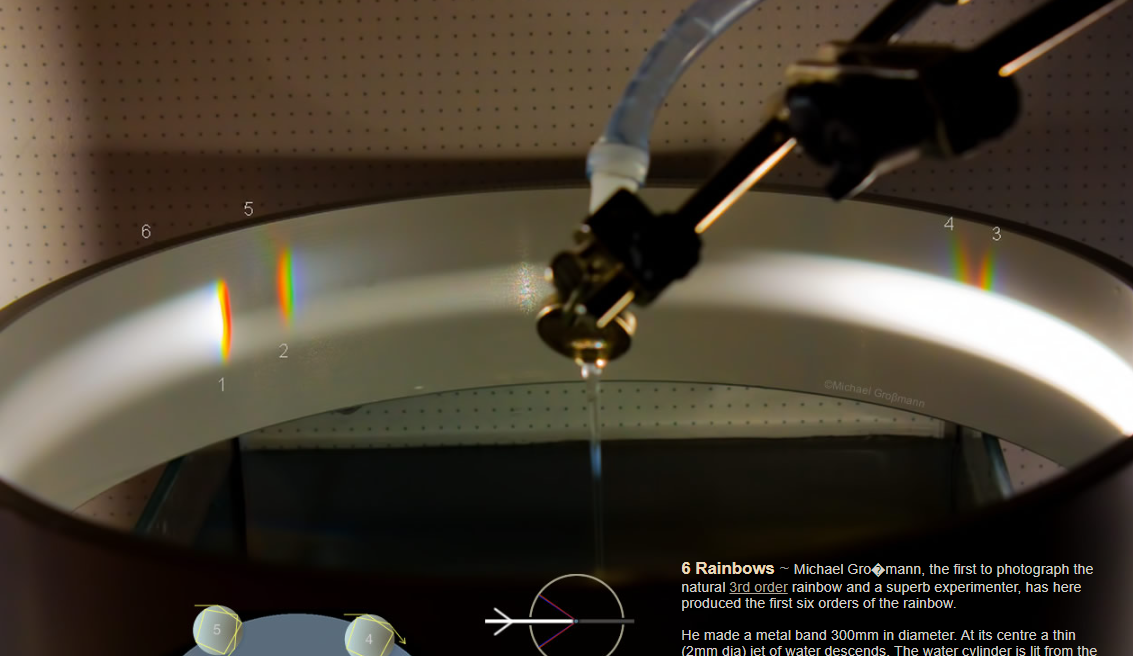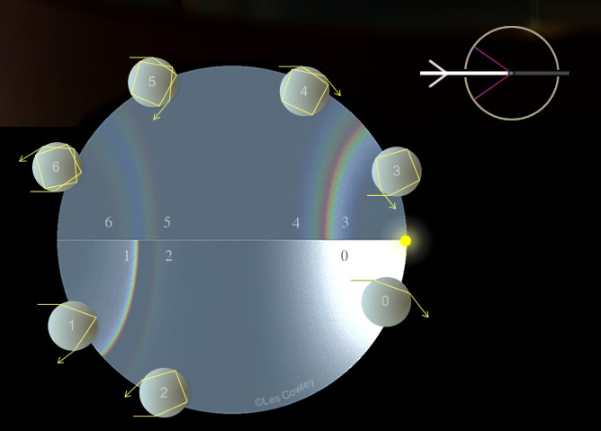OPOD - 6 rainbows
OPOD - 6 Rainbows: Unveiling the Spectacular World of Rainbow Orders
Rainbows have always fascinated us with their vibrant colors and ethereal beauty. We are familiar with the primary and secondary rainbows, but did you know that there are even more orders of rainbows that exist in nature? In this article, we will delve into the mesmerizing world of six rainbow orders, as captured by the talented photographer and experimenter, Michael Großmann.
The Experiment: Unveiling the Rainbow Orders
To capture the elusive higher order rainbows, Großmann ingeniously designed an experiment using a metal band with a diameter of 300mm. At the center of the band, a thin jet of water, only 2mm in diameter, descends. Illuminated by a parallel beam of light from a projector on the left, the water cylinder acts as a representation of a raindrop, unleashing an array of rainbows on its inner rim.
Here's a breakdown of what Großmann's experiment revealed:
- Primary Bow: The bright bow on the left side is the well-known primary bow, formed by light deflected back towards the sun. Its inner side is illuminated in white, mirroring the colors we observe in nature.
- Secondary Bow: Separated by Alexander's dark band, which appears as a narrow dark region, the reverse color secondary bow is located to the right of the primary bow.
- Zero Order Glow: Positioned near the 'sun,' the ring on the right side is illuminated by white light. This glow represents the zero order of rays passing through the water with slight deflection but no internal reflection.
Delving into Higher Order Rainbows
Now, let's embark on an enchanting journey into the realm of higher order rainbows unveiled by Großmann's experiment:
- 3rd and 4th Order Rainbows: By aligning the light beam precisely, Großmann succeeded in capturing the 3rd and 4th order rainbows. These bows are wider than the primary and secondary ones, and their faintness, combined with the brightness of the zero order glow, makes them incredibly challenging to observe.
- 5th and 6th Order Rainbows: On the left side of the experiment, light internally reflects five and six times within the water cylinder, giving rise to faint 5th and 6th order rainbows. Although these higher order rainbows are difficult to perceive, it is believed that with further advancements, someone will eventually capture the elusive 5th order rainbow, which partially lies within Alexander's dark band.
The Complexity Behind Großmann's Experiment
While Großmann's experiment appears deceptively simple, it required meticulous engineering, optics expertise, precise alignment, and significant effort to achieve a stable water jet. The ability to capture the intricate beauty of higher order rainbows demanded a comprehensive understanding of light refraction and reflection within raindrops.
Advancements in Simulation: Replacing Water with Silicon
To further explore the fascinating world of higher order rainbows, researchers have developed numerical ray tracing simulations. One such simulation, called HaloSim, replaces water with a water sphere and ice crystal with silicon and electrons. This modification enables the simulation of the first six orders of rainbows.
In this simulation, an all-sky view looking directly upwards is projected, with the 'sun' positioned on the horizon at the right. The sky's lower half, housing the primary and secondary bows and the zero order glow, is only 7.5% as bright as the upper part. By filtering out rays with less than three internal reflections, researchers ensure that the higher order bows are not overwhelmed by their lower order counterparts.
A Glimpse into Nature's 3rd Order Rainbow
On May 15, 2011, Michael Großmann achieved a significant milestone by capturing the first-ever photograph of a natural 3rd order rainbow. This extraordinary achievement took place in Kämpfelbach, located in southwest Germany. The photograph stands as a testament to the dedication and ingenuity required to unravel the mysteries of atmospheric optics.
As we continue to explore the captivating world of atmospheric optics, the discoveries made by visionaries like Michael Großmann remind us of the intricate beauty that surrounds us. The study of higher order rainbows not only deepens our understanding of light and water interactions but also invites us to marvel at the astonishing complexity of nature's artistic palette.

6 Rainbows ~ Michael Gro�mann, the first to photograph the natural 3rd order rainbow and a superb experimenter, has here produced the first six orders of the rainbow.
He made a metal band 300mm in diameter. At its centre a thin (2mm dia) jet of water descends. The water cylinder is lit from the left by a nearly parallel beam from a projector. The beam leaves through a hole at right.
The water cylinder acts as the central slice through a raindrop and sends forth rainbows which show up on the inner rim of the cylinder.
The bright bow at left is the familiar primary bow produced by light deflected back sunwards. The bow's inside is lit white as in nature. To the right of the primary - separated by Alexanders dark band - is the reverse colour secondary bow.
At right - near the 'sun' - the ring is lit by white light, the 'zero order glow' of rays passing through the water slightly deflected but not internally reflected.
Then the fun starts! Michael has aligned the light beam so that higher order bows appear slightly above the lower order ones and are not swamped by the latter. His 3rd order bow of three internal reflections inside a drop or cylinder appears at right with the 4th order bow nearby. They are wider than the primary and secondary. Their width, faintness and the bright sky from the zero order glow combine to make them almost impossible to see.
At left, light has internally reflected five and six times inside the water cylinder to produce faint 5th and 6th order rainbows. Someday someone will surely capture the 5th order as it partially lies inside Alexanders dark band.
Michael's experiment looks easy. It is not, it required careful engineering, optics, alignment and much effort to get a stable water jet.
Top and lower image ©Michael Gro�mann, shown with permission

Above: Silicon and electrons replace Michael's water, glass and metal. A modification of HaloSim where a water sphere has replaced an ice crystal produces a numerical ray tracing simulation of the first six orders of rainbow. The projection is an all-sky view looking directly upwards. The 'sun' is on the horizon at right. The sky is oriented to match Michael's experiment.
The sky lower half containing the primary and secondary bows and the zero order glow is only 7.5% of the brightness of the upper part.
The upper part was numerically filtered so that rays of less than three internal reflections were ignored. Had they been plotted the higher order bows would have been overwhelmed.

The first ever photograph of a natural 3rd order rainbow by Michael Gro�mann May 15, 2011 at K�mpfelbach in SW Germany.
Note: this article has been automatically converted from the old site and may not appear as intended. You can find the original article here.
Reference Atmospheric Optics
If you use any of the definitions, information, or data presented on Atmospheric Optics, please copy the link or reference below to properly credit us as the reference source. Thank you!
-
<a href="https://atoptics.co.uk/blog/opod-6-rainbows/">OPOD - 6 rainbows</a>
-
"OPOD - 6 rainbows". Atmospheric Optics. Accessed on November 24, 2024. https://atoptics.co.uk/blog/opod-6-rainbows/.
-
"OPOD - 6 rainbows". Atmospheric Optics, https://atoptics.co.uk/blog/opod-6-rainbows/. Accessed 24 November, 2024
-
OPOD - 6 rainbows. Atmospheric Optics. Retrieved from https://atoptics.co.uk/blog/opod-6-rainbows/.